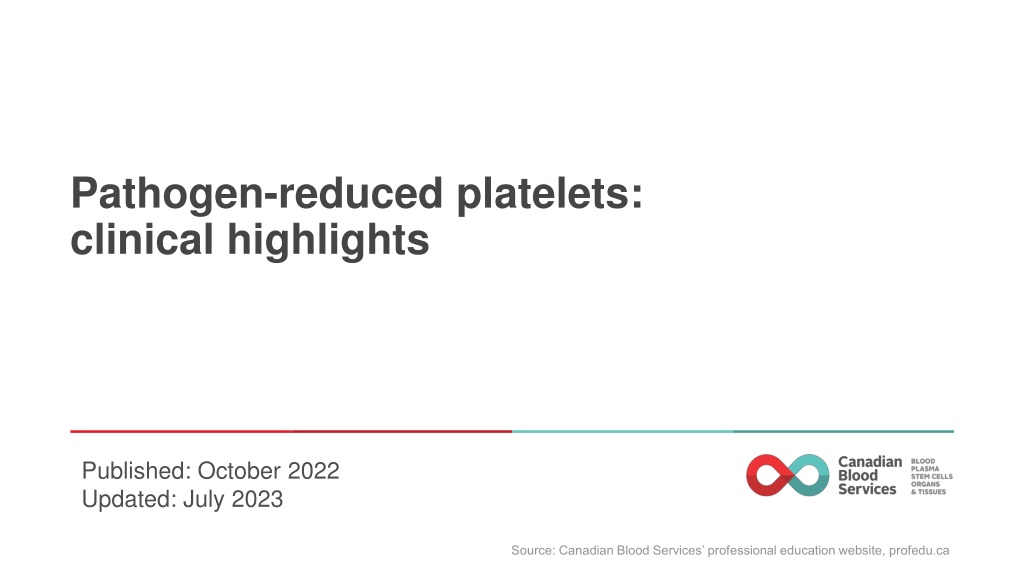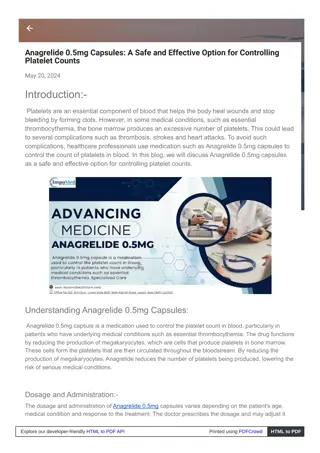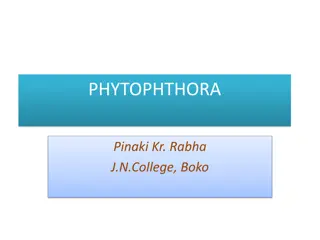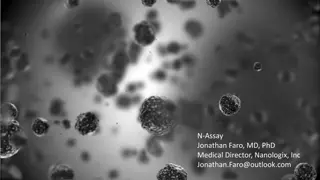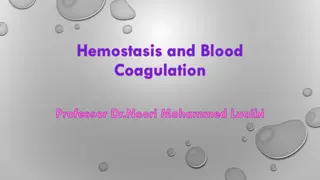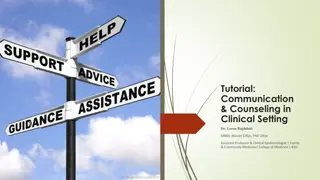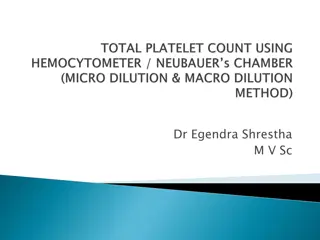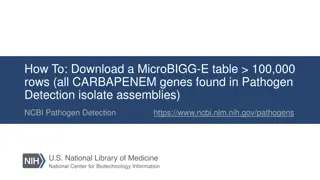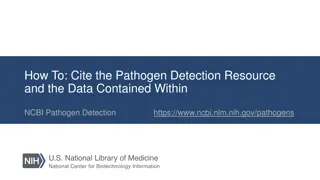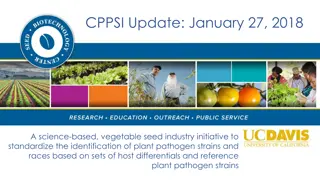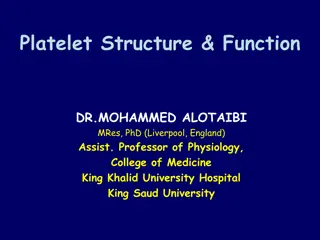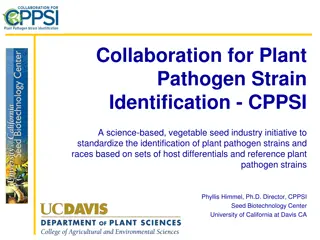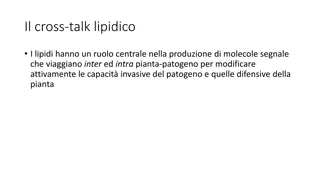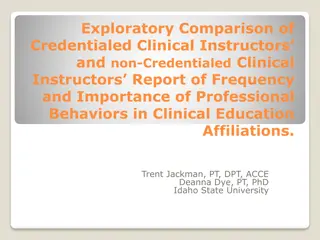Pathogen-reduced platelets: clinical highlights
Pathogen-reduced platelets play a crucial role in reducing the risk of transfusion-transmitted infections through pathogen inactivation technology (PIT). This technology provides an additional layer of safety against various pathogens including viruses, bacteria, protozoa, and leukocytes. Platelet components treated with PIT are known by various terms such as INTERCEPT platelets, PRT platelets, and psoralen-treated platelets. The safety profile of amotosalen, a key component in the pathogen reduction process, has been extensively studied and is considered safe based on in vitro, animal model, and hemovigilance data. Overall, pathogen-reduced platelets offer enhanced safety and efficiency in transfusion medicine.
Download Presentation

Please find below an Image/Link to download the presentation.
The content on the website is provided AS IS for your information and personal use only. It may not be sold, licensed, or shared on other websites without obtaining consent from the author. Download presentation by click this link. If you encounter any issues during the download, it is possible that the publisher has removed the file from their server.
E N D
Presentation Transcript
Pathogen-reduced platelets: clinical highlights Published: October 2022 Updated: July 2023 Source: Canadian Blood Services professional education website, profedu.ca
Acronyms Acronym Name PPPT Pooled platelet psoralen-treated APPT Apheresis platelet psoralen-treated PIT Pathogen inactivation technology PRT Pathogen reduction technology PAS Platelet additive solution PAS-E is the formulation of PAS used at Canadian Blood Services 2 Source: Canadian Blood Services professional education website, profedu.ca
Pathogen inactivation technology PIT reduces the risk of transfusion-transmitted pathogen infections and provides an additional layer of safety against: Viruses (enveloped and non-enveloped) Bacteria (gram-positive, gram-negative, spirochete) Protozoa parasites White blood cells (leukocytes), which can no longer replicate and produce cytokines, rendering irradiation unnecessary 3 Source: Canadian Blood Services professional education website, profedu.ca
Terminology At Canadian Blood Services, Cerus INTERCEPT pathogen inactivation technology (PIT) will be used to manufacture pathogen- reduced platelet components. Pathogen-reduced platelets are also known as: INTERCEPT platelets Pathogen reduction technology (PRT) platelets Psoralen-treated platelets Other terms: Pooled platelet psoralen-treated (PPPT) Apheresis platelet psoralen-treated (APPT) 4 Source: Canadian Blood Services professional education website, profedu.ca
Safety Amotosalen safety profile Toxicity extensively studied Minimal residual amotosalen In vitro, animal model, and European hemovigilance data suggests safe About INTERCEPT (provided by Cerus): Commercialized for nearly 20 years Adopted for the treatment of >50% of platelets produced in 10 Countries Approx. 8.5 million INTERCEPT treated doses globally (plasma and platelets)* Pathogen inactivated platelet concentrates Platelet concentrates screened for bacteria Platelet concentrates with neither bacterial screening nor pathogen inactivation Source: Cerus 2018 data on file Countries where INTERCEPT is standard of care, treating >50% of platelets *Dose treated estimates for platelet and plasma based on the number of kits sold to date 5
Platelet components Existing components, in plasma Untreated pooled platelet (Pooled platelets LR CPD) Untreated apheresis platelet (Apheresis platelet) New platelet components, in platelet additive solution (PAS-E) Pooled platelet psoralen-treated (PPPT) Apheresis platelet psoralen-treated (APPT) Untreated apheresis platelet in PAS-E 6 Source: Canadian Blood Services professional education website, profedu.ca
What is platelet additive solution (PAS) PAS was developed to partially replace plasma in platelet components Results in additional dilution of plasma proteins, cytokines, iso- agglutinins (anti-A, anti-B, anti-A/B), and other bio-active molecules Helps reduce the incidence of allergic reactions and febrile non- hemolytic transfusion reactions1,2 No differences in hemostasis and transfusion intervals3 7 Source: Canadian Blood Services professional education website, profedu.ca
Clinical indications Pathogen-reduced platelets have the same indications as untreated platelets with the following additional considerations: Irradiation not required/indicated CMV negative 8 Source: Canadian Blood Services professional education website, profedu.ca
Contraindications Pathogen-reduced platelets have the same contraindications as untreated platelets with the following additions: Contraindicated for patients with a history of hypersensitivity reaction to amotosalen or other psoralens Contraindicated for neonatal patients treated with phototherapy devices that emit a peak energy wavelength less than 425 nm, OR have a lower bound of the emission bandwidth <375 nm, due to the potential for erythema resulting from interaction between ultraviolet light and amotosalen 9 Source: Canadian Blood Services professional education website, profedu.ca
Benefits of pathogen-reduced platelets Reduces bacterial contamination risk and risks of other transfusion- transmitted infections4,5 complements donor selection criteria and pre-transfusion pathogen testing performed for all donations No need for routine BACT bacterial screening before release into inventory White blood cell inactivation irradiation is NOT required Contributes toward reducing the risk of TA-GVHD* Simpler ordering process and inventory management Considered CMV negative *Ta-GvHD: Transfusion-associated graft versus host disease 10 Source: Canadian Blood Services professional education website, profedu.ca
Benefits of pathogen-reduced platelets Safety endpoints from clinical trials and published hemovigilance data shows favourable adverse reaction and safety profile4,6 Fewer allergic and febrile non-hemolytic transfusion reactions7,8 Signals of safety (compared to untreated platelets) Cochrane review, 20176: No change in thromboembolism, anaphylaxis, acute transfusion reactions No increase in adverse events in clinical trials Short-term safety and efficacy have been demonstrated in pediatric patients and in neonates9,10 11 Source: Canadian Blood Services professional education website, profedu.ca
Clinical outcomes and drawbacks Pathogen-reduced vs untreated platelets No differences in mortality, any bleeding event (WHO Grade 1-4), clinically significant bleeding (Grade 2/more) or severe bleeding (Grade 3/4)6 Platelet count increments and transfusion requirements Lower correct count increment (CCI) at 1 and 24 hours 7% more platelet transfusions (published ranges from 0-30%) Shorter transfusion interval between platelets (avg. 0.5 days less between transfusion) Platelet refractoriness was observed more often (not HLA Ab-mediated) 12 Source: Canadian Blood Services professional education website, profedu.ca
A note about clinical efficacy - PLADO trial11 Method Prophylactic platelet transfusion to hematologic cancer and solid tumor patients Received low (1.1x1011), medium (2.2x1011), or high (4.4x1011) dose when platelet count was less than 10,000/L Primary endpoint: Grade 2 or higher bleeding defined by WHO Result Significant bleeding did not differ between groups Trials with pathogen-reduced platelets also did not observe an increased bleeding risk due to fewer platelets in a platelet dose.8 13 Source: Canadian Blood Services professional education website, profedu.ca
Neonatal and intrauterine transfusions Several studies have described pathogen reduced platelet use in pediatrics and neonatal populations No indications of harm Largest study Delaney et al. > 3800 pediatric patients across 4 centres, 2013-2019 (1,188 patients under 4 months)12 No long-term studies No published studies in intrauterine transfusions Benefit and risks should be assessed and balanced before using pathogen-reduced platelets in these settings 14 Source: Canadian Blood Services professional education website, profedu.ca
Resources Canadian Blood Services professional education website (profedu.ca) Clinical Guide to Transfusion, Chapter 19, Pathogen-reduced platelets Clinical slide deck (also available as narrated video) Component slide deck (also available as narrated video) Clinical highlights slide deck (also available as narrated video) FAQ: Information for health professionals on pathogen-reduced platelets (PPPT) FAQ: Information for health professionals on apheresis platelet psoralen-treated (APPT) and untreated apheresis platelet in PAS-E Canadian Blood Services website (blood.ca) Circular of Information INTERCEPT package insert: intercept-canada.com Ontario Regional Blood Coordinating Network (ORBCoN) information on pathogen-reduced pooled platelets: Information on Pathogen Reduced Pooled Platelets Transfusion Ontario 15 Source: Canadian Blood Services professional education website, profedu.ca
References 1. Mertes PM et al. Hypersensitivity Transfusion Reactions to Platelet Concentrate: A Retrospective Analysis of the French Hemovigilance Network. Transfusion 2020;60:507-12. 2. Mowla SJ et al. A Comparison of Transfusion-Related Adverse Reactions among Apheresis Platelets, Whole Blood-Derived Platelets, and Platelets Subjected to Pathogen Reduction Technology as Reported to the National Healthcare Safety Network Hemovigilance Module. Transfus Med Rev 2021;35: 78-84. 3. Kerkhoffs J-LH et al. A Multicenter Randomized Study of the Efficacy of Transfusions with Platelets Stored in Platelet Additive Solution Versus Plasma. Blood 2006;108:3210-5. 4. Knutson F et al. A Prospective, Active Haemovigilance Study with Combined Cohort Analysis of 19,175 Transfusions of Platelet Components Prepared with Amotosalen-UVA Photochemical Treatment. Vox Sang 2015;109:343-52. 5. Benjamin RJ et al. Hemovigilance Monitoring of Platelet Septic Reactions with Effective Bacterial Protection Systems. Transfusion 2017;57:2946-57. 6. Estcourt LJ et al. Pathogen Reduced Platelets for the Prevention of Bleeding. Cochrane Database of Systematic Reviews 2017. 7. Garban F et al. Comparison of the Hemostatic Efficacy of Pathogen-Reduced Platelets Vs Untreated Platelets in Patients with Thrombocytopenia and Malignant Hematologic Diseases: A Randomized Clinical Trial. JAMA Oncology 2018;4:468-75. 8. Jutzi M, Mansouri Taleghani B, Rueesch M, Amsler L, Buser A. Nationwide Implementation of Pathogen Inactivation for All Platelet Concentrates in Switzerland. Transfus Med Hemother 2018;45:151-6. 9. Schulz WL et al. Blood Utilization and Transfusion Reactions in Pediatric Patients Transfused with Conventional or Pathogen Reduced Platelets. J Pediatr 2019;209:220-5. 10. Jimenez-Marco T et al. Use and Safety of Riboflavin and Uv Light-Treated Platelet Transfusions in Children over a Five-Year Period: Focusing on Neonates. Transfusion 2019;59:3580-8. 11. Slichter SJ, et al. Dose of prophylactic platelet transfusions and prevention of hemorrhage. N Engl J Med 2010;362(7):600-13 12. Delaney M et al,. Multinational Analysis of Transfusion Reactions in Children Transfused with Pathogen Inactivated Platelets. 2021 AABB Annual Meeting, Virtual, Transfusion 2021 16 Source: Canadian Blood Services professional education website, profedu.ca
